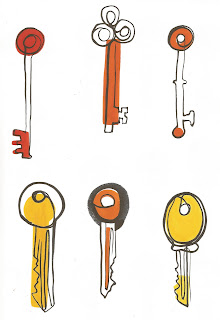I tried to apply the process of breaking down an image to money as it is something familiar that may become unrecognisable to someone with dementia. This isn't working well.
Why? Aside from the little details on a coin, the general shape is round and too simple to dissect and distort. The colour is too distinctive to play around with. I am going to move away from the money idea.

Keys. I took inspiration from the lost property video for this subject matter. I like how this process is developing. A more complex shape works better because it can be split up into smaller, simpler shapes. Even when broken down into fragments it is still recognisable what it is.
I can see my line work improving just over these two pages, the fluidity of brush pen is working well for continuous line drawings. It gives a clear outline while showing confusion and abnormality at the same time. Keep going with this.
I tried the continuous line process over some past camera images. I think this process of layering shape and line could work well across all my images, it just isn't working well on this example. The colour painting here is a bit too complex as there is orange line work which causes a clash with the black. Do I use this line work for the whole image or just small detailed parts like the lens and where the buttons are...? Something to think about.
I think the combination of these processes has potential. I also think that with some more development, the I can make the shape element fit with the 50s theme I have been looking at. Using my research as a direct influence from this point onwards might drive my work to a more developed stage.
Synthesis with essay...
I am now reaching a point in this project where I have used my research about the social issue to develop a visual style that reflects the issue itself. Now i'm moving on to making this fit in with my trend research it moves on to making the images marketable to a certain audience. I think now is the turning point between a project driven by a care for a social issue and a project driven by commercial potential. This is what I have been trying to get at through doing this project - understanding where this change in approach happens.

































